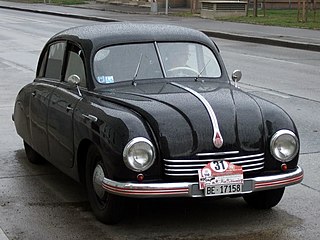
The Tatra 600, named the Tatraplan, was a rear-engined large family car produced from 1948 to 1952 by the Czech manufacturer Tatra. The first prototype was finished in 1946.

Tatra is a Czech vehicle manufacturer from Kopřivnice. It is owned by the TATRA TRUCKS a.s. company, and it is the third oldest company in the world producing motor vehicles with an unbroken history. The company was founded in 1850 as Ignatz Schustala & Cie. In 1890 the company became a joint-stock company and was renamed the Nesselsdorfer Wagenbau-Fabriksgesellschaft. In 1897, the Nesselsdorfer Wagenbau-Fabriksgesellschaft produced the Präsident, which was the first factory-produced automobile with a petrol engine to be made in Central and Eastern Europe. In 1918, the company was renamed Kopřivnická vozovka a.s., and in 1919 it changed from the Nesselsdorfer marque to the Tatra badge, named after the nearby Tatra Mountains on the Czechoslovak-Polish border.

In automotive design, an RR, or rear-engine, rear-wheel-drive layout places both the engine and drive wheels at the rear of the vehicle. In contrast to the RMR layout, the center of mass of the engine is between the rear axle and the rear bumper. Although very common in transit buses and coaches due to the elimination of the drive shaft with low-floor buses, this layout has become increasingly rare in passenger cars.
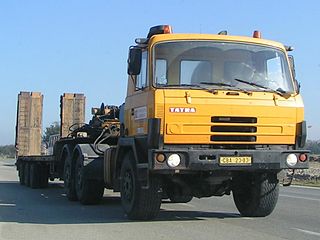
The Tatra 815 is a truck family, produced by Czech company Tatra. It uses the traditional Tatra concept of rigid backbone tube and swinging half-axles giving independent suspension. The vehicles are available in 4x4, 6x6, 8x8, 10x8, 10x10, 12x8 and 12x12 variants. There are both air-cooled and liquid-cooled engines available with power ranging from 230–440 kilowatts (310–590 hp). As a successor to Tatra 813 it was originally designed for extreme off-road conditions, while nowadays there are also variants designated for mixed use. The gross weight is up to 35,500 kg (78,264 lb).
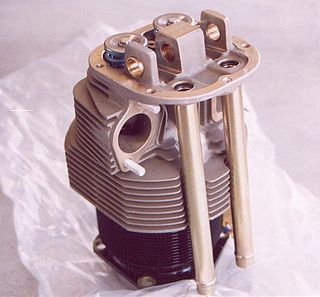
Air-cooled engines rely on the circulation of air directly over heat dissipation fins or hot areas of the engine to cool them in order to keep the engine within operating temperatures. Air-cooled designs are far simpler than their liquid-cooled counterparts, which require a separate radiator, coolant reservoir, piping and pumps.

BEML Limited, formerly Bharat Earth Movers Limited, is an Indian public sector undertaking which manufactures a variety of heavy equipment, such as that used for earth moving, railways, transport and mining. It is headquartered in Bangalore. BEML is Asia's second-largest manufacturer of earth moving equipment. Its stock trades on the National Stock Exchange of India under the symbol "BEML", and on the Bombay Stock Exchange under the code "500048".

The Tatra 77 (T77) is one of the first serial-produced, truly aerodynamically-designed automobiles, produced by Czechoslovakian company Tatra from 1934 to 1938. It was developed by Hans Ledwinka and Paul Jaray, the Zeppelin aerodynamic engineer. Launched in 1934, the Tatra 77 is a coach-built automobile, constructed on a platform chassis with a pressed box-section steel backbone rather than Tatra's trademark tubular chassis, and is powered by a 60 horsepower (45 kW) rear-mounted 2.97-litre air-cooled V8 engine, in later series increased to a 75 horsepower (56 kW) 3.4-litre engine. It possessed advanced engineering features, such as overhead valves, hemispherical combustion chambers, a dry sump, fully independent suspension, rear swing axles and extensive use of lightweight magnesium alloy for the engine, transmission, suspension and body. The average drag coefficient of a 1:5 model of Tatra 77 was recorded as 0.2455. The later model T77a, introduced in 1935, has a top speed of over 150 km/h (93 mph) due to its advanced aerodynamic design which delivers an exceptionally low drag coefficient of 0.212, although some sources claim that this is the coefficient of a 1:5 scale model, not of the car itself. Recent article confirmed the Tatra 77/77a drag coefficient for real full-size car as 0.36.

The Tatra 613 is a large luxury rear wheel driven car with rear-mounted air-cooled engine manufactured by Czechoslovak manufacturer Tatra from 1974 until 1996 as a replacement for the Tatra 603 series.

The Tatra 700 is a rear-engined luxury car released in 1996 by the Czech car maker Tatra. It was essentially a heavily restyled version of the Tatra 613 model it replaced. It is one of the last production cars with an air-cooled engine.
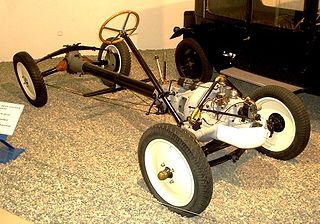
Backbone tube chassis is a type of automobile construction chassis that is similar to the body-on-frame design. Instead of a two-dimensional ladder-type structure, it consists of a strong tubular backbone that connects the front and rear suspension attachment areas. A body is then placed on this structure. It was first used in the English Rover 8hp of 1904 and then the French Simplicia automobile in 1909.

The TatraT813 was a truck produced in Czechoslovakia by the Tatra company. It was produced from 1967 to 1982. The basic representative of this series was a military version of the 8×8 Kolos (Colossus), which was able to pull trailers up to a total weight of 100 tons. Tatra also produced a civilian version in either 6×6 or 4×4. After fifteen years of production, 11,751 vehicles were built in all modifications. Many units were exported to the USSR, East Germany, Romania and India.

The Tatra 148 was a truck produced in Czechoslovakia by the Tatra company.

The Tatra 87 (T87) is a car built by Czechoslovak manufacturer Tatra. It was powered by a rear-mounted 2.9-litre air-cooled 90-degree overhead cam V8 engine that produced 85 horsepower and could drive the car at nearly 100 mph (160 km/h). It is ranked among the fastest production cars of its time. Competing cars in this class, however, used engines with almost twice the displacement, and with fuel consumption of 20 liters per 100 km. Thanks to its aerodynamic shape, the Tatra 87 had a consumption of just 12.5 litres per 100 km. After the war between 1950 and 1953, T87s were fitted with more-modern 2.5-litre V8 T603 engines.

The Tatra 80 is a Czechoslovak luxury full-size car built by Tatra between 1931 and 1935.

The Tatra 111 was a truck produced in Czechoslovakia by the Tatra company.

The Tatra 603 is a large rear-engined luxury car which was produced by the Czechoslovak company Tatra from 1956 to 1975. It was a continuation of the series of Tatra streamlined sedans which began with the Tatra 77. In Socialist Czechoslovakia, only high-ranking party officials and heads of factories were driven in 603s; the car was also exported to a number of other countries.

The Tatra 57 are a series of two-door compact cars, built by Czechoslovakian company Tatra from 1932. They are popularly known by the nickname "Hadimrška".
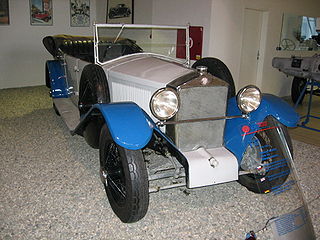
The Tatra 17 is an automobile produced by the Czech manufacturer Tatra between 1925 and 1929. It was the company's top-end model, and was sold alongside the Tatra 12 economy car and the Tatra 30 executive car.

The Tatra 601 Monte Carlo was a vehicle based on the Tatra 600 manufactured by Czech company Tatra and built in 1949. The Tatra 601 Monte Carlo was a two-door sports car with possibly only two units built. Although the 601 was named after the Monte Carlo race, it never competed in it, but it did compete in the Alpenfahrt Rally.
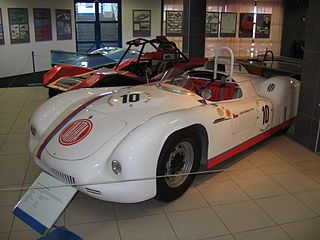
The Tatra 602 Tatraplan Sport is a racing car produced by Tatra in 1949.




















